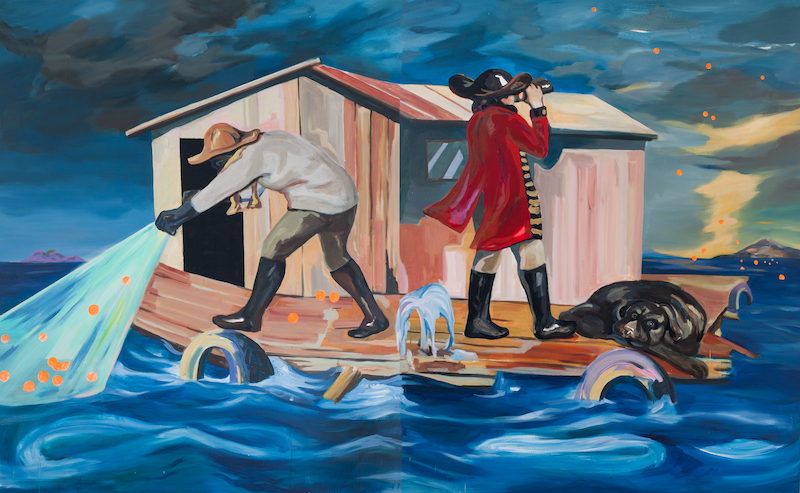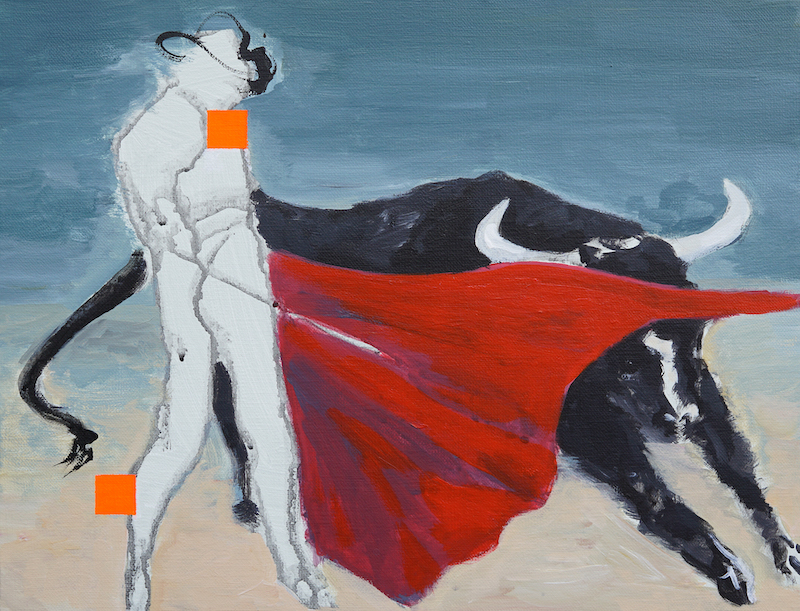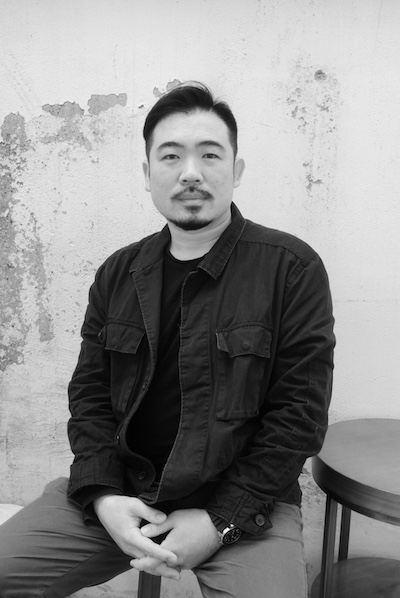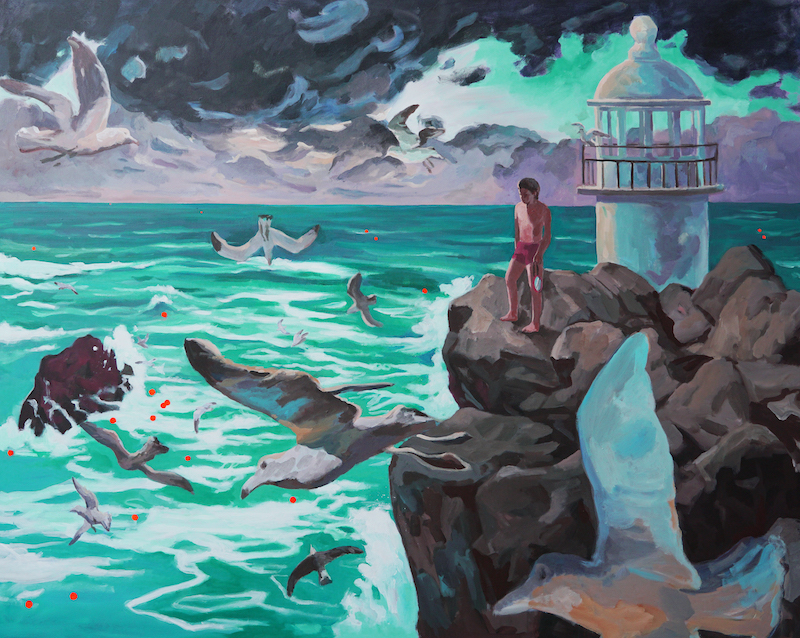Painting a Landscape of the Mind – Artist Lee In-sung
By Kang Jennis Hyunsuk
Upon encountering Lee In-sung’s paintings, my eyes focused on scenes featuring rolling waves on the sea, graceful seagulls, and the captivating presence of a young man. Learning that his hometown was Haenam, nestled close to the sea, I couldn’t help but speculate that in each stroke of his brush, the artist engaged in a personal dialogue with himself. Being from Haenam, the most distant corner of the peninsula from the vortex of Seoul, Lee’s artistic journey unfolded organically. Remarkably, he never underwent formal training in a professional art academy. Instead, his early artistic expression took the form of graffiti-like sketches on paper, a fondness cultivated in his youth. His path led him to Haenam High School, where he delved into diverse genres of painting, founded a cartoon club with his friends, and ultimately enrolled in the College of Fine Arts at Chosun University. Intrigued by his artistic style, I recently paid a visit to Lee’s studio, eager to unravel the narrative behind his creations and to share the story of his art with the readers of the Gwangju News. Here is our conversation:
Jennis: Thank you so much for granting me this interview. A few years back, I attended your exhibition at the Gwangju Ha Jung-woong Museum of Art, and your artworks sparked my curiosity.
Lee In-sung: Thank you. The Gwangju Museum of Art selects one young artist annually and holds an exhibition spotlighting their works. I am honored to have been chosen as the Gwangju Young Artist in 2021, leading to a three-month invitational exhibition starting in December of that year.
Jennis: The exhibition was titled “I Am Ground.” Could you explain its significance?
Lee In-sung: Certainly. The title draws inspiration from a game called “I’m Ground, I’ll Introduce Myself,” where ground symbolizes basic soil. I aimed to introduce myself, Lee In-sung, through my fundamental colors, signifying that painting fundamentally begins with self-exploration. Additionally, “I Am Ground” carries another layer of meaning, representing the grounds where sporting events are held. While staying at the Beijing Residency – I was recommended by the Gwangju Museum of Art – I witnessed a man practicing with a tennis ball tied to his racket. Initially amusing, I suddenly realized I wasn’t so different: I was holding a metaphorical tennis ball called “painting.” Perhaps we’re all vigorously pursuing personal goals in our respective grounds.
Jennis: Your paintings often feature the sea. Does this inclination stem from your upbringing near the coast?
Lee In-sung: While its proximity to the sea might play a role, the primary motivation behind portraying the sea in my paintings is to capture the ever-changing facets of life through the sea’s diverse expressions.
Jennis: I’ve noticed orange dots, and sometimes squares, in your paintings. What do they represent?
Lee In-sung: The orange dots could serve as directional markers to overcome life’s challenges or symbolize the value in our lives that we seek. They encapsulate dreams or hopes and originated as an experiment driven by my curiosity – questioning why abstraction and conception couldn’t coexist on a single canvas. The orange dots, small figurative elements, aim to capture the reality I navigate.

Jennis: Your exhibition at the Woo Je-gil Museum of Art was titled Querencia. What does it signify?
Lee In-sung: “Querencia” alludes to a place where bulls catch their breath during a bullfight. Amid the unexpected isolation of the Covid-19 era, people experienced ambivalence, oscillating between the fear of infection and the guilt associated with that fear. I envisioned those navigating emotional instability during uncertain times as being akin to a bull or a bullfighter in a bullring. Like them, we could either be the bull or the bullfighter – ultimately, we are not separate entities. Querencia serves as a sanctuary for modern-day individuals in the midst of uncertainty. This is what I explored in my Querencia series.

Jennis: Your artwork at Art Gwangju caught my attention, particularly the one featuring a boy on the beach. The absence of detailed descriptions leaves room for imagination. You didn’t reveal the characters in the picture in detail, but the harmony of the colors that split the screen was so appealing that I felt that the artist purposely painted with restraint. When do you believe you developed your distinctive painting style?
Lee In-sung: During my time at Chosun University’s College of Arts, I constantly compared my paintings with those of talented friends, striving for improvement. I practiced like a vocalist trying to have the finest voice. Professor Kim Jong-su, who specialized in portrait painting, compared my work to Fauvism art, acknowledging its unique charm. This recognition prompted me to focus on my individual expression, concentrating on psychological situations rather than intricate details, and no longer comparing my work with that of my classmates.
Jennis: Most of your paintings are acrylic, yet they exude an oil paint aesthetic rather than the brightness of acrylic. How do you achieve this color palette?
Lee In-sung: Before painting on canvas, like many artists, I sketch on a small paper called esquisse. Once the outline is ready, I quickly transfer it to a larger canvas. Acrylic paints, drying faster than oil paints, prompt me to work rapidly before drying occurs. I aspire to be an artist unbound by specific colors or themes, creating a diverse range of feelings.
[Include Photo 4 near this text: A Wonderful Summer Day]

Jennis: I heard you’re married to a fellow artist, Sung Hye-rim. Do you believe being an artist couple has advantages?
Lee In-sung: Absolutely. Sharing the same artistic field broadens our understanding of each other. As fellow artists on parallel journeys, we mutually support one another.
Jennis: Considering your experiences as a resident artist in various Asian cities, including Beijing and Yokohama as well as Gwangju, and your current role lecturing at Chosun University, I wonder what your future plans are.
Lee In-sung: The Gwangju Museum of Art is actively promoting Gwangju artists internationally. In early November, there will be an exhibition at the Hanoi National Museum of Art, which includes several Gwangju artists, and another in Jakarta, Indonesia. Additionally, in mid-November, I just finished working on artworks at the Gana Art Studio in Yangju.
Jennis: Your schedule seems packed with artwork activities and exhibitions. I wish you success, and I look forward to seeing you at one of your upcoming exhibitions. Thank you for this extensive interview.
After the Interview…
Lee In-sung skillfully reconstructs the ironic social phenomena he encounters and captures memorable moments from his daily life through metaphors and symbolic elements. His artworks serve as poignant reminders of the often-overlooked, invisible facets of our existence, prompting the audience to reflect on the deeper meaning of life.

Lee In-sung’s Profile
2007 BFA from the College of Fine Arts, Chosun University
2010 MFA from the Department of Art, Chosun University
17 Solo Exhibitions
Selected Group Exhibitions
2022 What’s in My Bag. De Young Art Museum, Gwangju
2021 Korean Young Artists’ Series. Korean Culture Center, Hong Kong
2021 May 18 Uprising Special Exhibition. Gwangju Biennale, Gwangju
2020 With Strong Roots. Po Kim and Sylvia Wald Museum, Gwangju
2019 Dive into You. Eunam Art Gallery, Gwangju
2019 In Your View. Asia Culture Center, Gwangju
2018 Night Hiking. Art Space Hue, Paju, Korea
2017 Arena. Taipei Fine Arts Museum, Taipei
2017 Lotus Land. Asia Culture Center, Gwangju
2016 Gwangju Biennale Portfolio Review. Lotus Culture Center, Gwangju
2015 Ignition (点火). Lazy Dragon Studio, Beijing
2015 Gwangju Young Artist Exhibition: Question. GMA Gallery, Seoul
2014 Flower Project. Koganecho Bazaar, Yokohama, Japan
2012 I Love You. Korean Cultural Center in Shanghai, Shanghai
2011 Beijing Residency of Gwangju Museum of Art. Beijing
Residencies
2014 Koganecho Bazaar Residency, Yokohama, Japan
2013 Mite-Ugro Residency, Gwangju, Korea
2011 Gwangju Museum of Art Residency – Beijing, China
2010 Gwangju Museum of Art Residency – Yangsan-dong, Gwangju, Korea
Email: hisdy@naver.com
The Author/Interviewer
Kang Jennis Hyunsuk is a lifelong resident of Gwangju. She has been doing oil painting for almost a decade, and she has learned that there are a lot of fabulous artists in this City of Art. As a freelance interpreter and translator, her desire is to introduce these wonderful artists to the world. Instagram: @jenniskang







